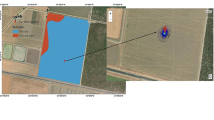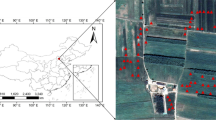Abstract
Crop growth and weed infestation in a soybean field were monitored by processing low altitude remote sensing (LARS) images taken from crane-mounted and unmanned radio controlled helicopter-mounted platforms. Images were taken for comparison between true color (R–G–B) and color-infrared (NIR) digital cameras acquired at different heights above ground. All LARS images were processed to estimate vegetation-indices for distinguishing stages of crop growth and estimating weed density. LARS images from the two platforms (low-dynamic and high-dynamic) were evaluated. It was found that crane-mounted RGBC and NIRC platforms resulted in better quality images at lower altitudes (<10 m). This makes the crane-mounted platform an attractive option in terms of specific low altitude applications at an inexpensive cost. Helicopter-mounted RGBH and NIRH images were found suitable at altitudes >10 m. Comparison of NDVIC and NDVIH images showed that NDVI values at 28 DAG (days after germination) exhibited a strong relationship with altitudes used to capture images (R 2 of 0.75 for NDVIC and 0.79 for NDVIH). However, high altitudes (>10 m) decreased NDVI values for both systems. Higher R 2 values (≥0.7) were also obtained between indices estimated from crane-and helicopter-mounted images with those obtained using an on-ground spectrometer, which showed an adequate suitability of the proposed LARS platform systems for crop growth and weed infestation detection. Further, chlorophyll content was well correlated with the indices from these images with high R 2 values (>0.75) for 7, 14, 21 and 28 DAG.











Similar content being viewed by others
References
Chaisattapagon, C., & Zhang, N. (1995). Effective criteria for weed identification in wheat fields using machine vision. Transactions of the American Society of Agricultural and Biological Engineers, 38(3), 965–974.
Hunt, E. R., Cavigelli, M. A., Daughtry, C. S., McMurtrey, J. E., & Walthall, C. L. (2005). Evaluation of aerial photography from model aircraft for remote sensing crop biomass and nitrogen status, Precision Agriculture, 6(4), 359–378. doi:10.1007/s11119-005-2324-5.
James, J. S. T., Goodman, L., Franz, H., & Armanini, M. P. (1996). Characterization of a multi-component receptor for GDNF, Letters to nature, Nature 382, 80–83. doi:10.1038/382080a0.
Kim, K., & Chavas, J. P. (2003). Technological change and risk management: an application to the economics of corn production. Agricultural Economics, 29(2), 125–142.
Koundauri, P., Nauges, C., & Tzouvelekas, V. (2006). Technology adoption under production uncertainty: theory and application to irrigation technology. American Journal of Agricultural Economics, 88(3), 657–670.
Markwell, J., Osterman, J. C., & Mitchell, J. L. (1995). Calibration of the Minolta SPAD-502 leaf chlorophyll meter. Photosynthesis Research, 46, 467–472.
Meyer, K. (1998). A program to estimate covariance functions for longitudinal data by restricted maximum likelihood, Proceedings of the 6th World Congress on Genetics Applied to Livestock Production, Armidale, 27, 465–466
Samseemoung, G., Jayasuriya, H. P. W., & Soni, P. (2011). Oil palm pest infestation monitoring and evaluation by helicopter-mounted, low altitude remote sensing platform, Journal of Applied Remote Sensing, 5, 053540; doi:10.1117/1.3609843.
Stafford, J. V. (2000). Implementing precision agriculture in the 21st century. Journal of Agricultural Engineering Research, 76(3), 267–275.
Stafford, J. V., & Benloch, J. V. (1997). Machine assisted detection of weeds and weed patches, Precision Agriculture’97 Oxford, BIOS Scientific Publishers Limited, pp. 511–518.
Steven, M. D. (1993). Satellite remote sensing for agricultural management: opportunities and logistic constraints. ISPRS Journal of Photogrammetry and Remote Sensing, 48(4), 29–34.
Swain, K. C., & Jayasuriya, H. P. W. (2007). Land-use suitability evaluation criteria for precision agriculture adoption in a moderately yielding soybean cropping area in Thailand. Asia-Pacific Journal of Rural Development, 17(1), 113–125.
Tangwongkit, R., Salokhe, V. M., & Jayasuriya, H. P. W. (2006). Development of a real-time, variable rate herbicide applicator using machine vision for between-row weeding of sugarcane fields. The CIGR E-Journal, 8, 1–12.
Tian, L., Reid, J. F., & Hummel, J. (1999). Development of a precision sprayer for site-specific weed management. Transactions of the ASAE, 42(4), 893–900.
Tillet, N. D., Marchant, J. A., & Hague, T. (1996). Autonomous plant scale crop protection, Abstracts of the International Conference on Agricultural Engineering, AgEng Madrid 96, Paper No. 96A-124, pp. 255–256.
Acknowledgments
The authors thank Asian Institute of Technology (AIT), School of Environment, Resources and Development, Agricultural Systems and Engineering, Pathumthani, for providing experimental facilities. This work was financially supported by Rajamangala University of Technology Thanyaburi (RMUTT), Faculty of Engineering, Agricultural Engineering, Klong 6, Thanyaburi, Pathumthani, Thailand.
Author information
Authors and Affiliations
Corresponding author
Rights and permissions
About this article
Cite this article
Samseemoung, G., Soni, P., Jayasuriya, H.P.W. et al. Application of low altitude remote sensing (LARS) platform for monitoring crop growth and weed infestation in a soybean plantation. Precision Agric 13, 611–627 (2012). https://doi.org/10.1007/s11119-012-9271-8
Published:
Issue Date:
DOI: https://doi.org/10.1007/s11119-012-9271-8




